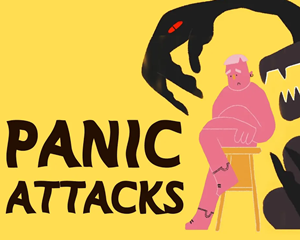The body becomes its own corset. Past, present, and future exist as a single force.
身体成为了它自己的盔甲。过去,现在和未来凝聚成同一股力量。
A swing without gravity soars to a terrifying height. The outlines of people and things dissolve.
就像没有重力约束的秋千翱翔到了令人恐怖的高度。人与物的边界线开始融化。
Countless poets and writers have tried to put words to the experience of a panic attack
无数的诗人与作家试图将急性焦虑症的症状用文字描绘下来,
a sensation so overwhelming, many people mistake it for a heart attack, stroke, or other life-threatening crisis.
这是一种排山倒海的感觉,许多人误把它当成心脏病发作、中风,或其他致命的危机。
Though panic attacks don't cause long-term physical harm, afterwards, the fear of another attack can limit someone's daily life -- and cause more panic attacks.
虽然急性焦虑症不会对身体造成长期危害,但是,对于下一次病情复发的恐惧会限制一个人的日常生活--并且会使急性焦虑症多次复发。
Studies suggest that almost a third of us will experience at least one panic attack in our lives.
研究表明,我们当中近三分之一的人在一生中都会至少体验一次急性焦虑症。
And whether it's your first, your hundredth, or you're witnessing someone else go through one, no one wants to repeat the experience.
无论这是你第一次,还是第一百次,还是你正在目睹别人的一次经历,没人想要重复这种经历。
Even learning about them can be uncomfortable, but it's necessary -- because the first step to preventing panic attacks is understanding them.
即使学习关于它的点点滴滴会使我们不安,但这是必须的--因为阻止急性焦虑症的第一步就是了解它们。
At its core, a panic attack is an overreaction to the body's normal physiological response to the perception of danger.
急性焦虑症的本质,是身体面对危险时正常的生理状态。
This response starts with the amygdala, the brain region involved in processing fear.
这种生理反应开始于杏仁核,它是大脑内负责处理恐惧的区域。
When the amygdala perceives danger, it stimulates the sympathetic nervous system, which triggers the release of adrenaline.
杏仁核感受到恐惧的时候,它会刺激交感神经系统,从而使身体释放出肾上激素。
Adrenaline prompts an increase in the heart and breathing rate to get blood and oxygen to the muscles of the arms and legs.
肾上激素会加快心跳和呼吸频率,使血液和氧气更快地抵达手臂和腿的肌肉。
This also sends oxygen to the brain, making it more alert and responsive.
同时,大脑也会接收更多氧气,让它变得更加警惕和敏捷。
During a panic attack, this response is exaggerated well past what would be useful in a dangerous situation,
当急性焦虑症发作时,这种反应被夸大了,远远超过了在危险情况下必要的程度,
causing a racing heart, heavy breathing, or hyperventilation.
使得心脏快速跳动,呼吸沉重或过度换气。
The changes to blood flow cause lightheadedness and numbness in the hands and feet. A panic attack usually peaks within 10 minutes.
血液流动的变化会造成晕眩和手脚的麻木。急性焦虑症的症状通常会在十分钟内到达顶峰。
Then, the prefrontal cortex takes over from the amygdala and stimulates the parasympathetic nervous system.
随后,前额叶皮层将取代杏仁核,并刺激周边神经系统。
This triggers the release of a hormone called acetylcholine that decreases the heart rate and gradually winds down the panic attack.
这会刺激大脑释放一种叫乙酰胆碱的荷尔蒙,它会降低心率,并逐渐减缓急性焦虑症。
In a panic attack, the body's perception of danger is enough to trigger the response we would have to a real threat -- and then some.
在急性焦虑症发作时,身体对于危险的感知足够触发我们面对真正威胁时的反应。
We don't know for sure why this happens, but sometimes cues in the environment that remind us of traumatic past experience can trigger a panic attack.
我们目前还不了解它发生的原因,有时,环境中的一些线索会让我们想起过去那些创伤性的经历,从而引发急性焦虑症。
Panic attacks can be part of anxiety disorders like PTSD, social anxiety disorder, OCD, and generalized anxiety disorder.
急性焦虑症是焦虑症的一种,后者还包括创伤后遗症、社交恐惧、强迫症和广泛性焦虑障碍。

Recurring panic attacks, frequent worry about new attacks, and behavioral changes to avoid panic attacks can lead to a diagnosis of a panic disorder.
反复发作的急性焦虑症,频繁担心新的发作,甚至为避免发作而做出的行为改变,都可能导致恐慌症的诊断。
The two main treatments for panic disorder are antidepressant medication and cognitive behavioral therapy, or CBT.
针对恐慌症,两种主要的治疗手段是,使用抗抑郁药物和认知行为疗法(CBT)。
Both have about a 40% response rate -- though someone who responds to one may not respond to the other.
两者的有效率都大约为40%--然而对其中一种治疗方法产生反应的人不一定会对另一种做出反应。
However, antidepressant medications carry some side effects, and 50% of people relapse when they stop taking them.
不过,抗抑郁药物有一些副作用,而且50%的人会在停止服用后复发。
CBT, meanwhile, is more lasting, with only a 20% relapse rate.
但是,认知行为疗法会更加持久,只有20%的复发率。
The goal of CBT treatment for panic disorder is to help people learn and practice concrete tools
认知行为疗法的目的是帮助人们学习和练习具体的方法,
to exert physical, and in turn mental, control over the sensations and thoughts associated with a panic attack.
从而在身体上和精神上控制与急性焦虑症相关的感觉和想法。
CBT begins with an explanation of the physiological causes of a panic attack,
认知行为疗法从解释急性焦虑症的心理原因开始,
followed by breath and muscle exercises designed to help people consciously control breathing patterns.
然后通过一些设计好的呼吸和肌肉练习来帮助人们有意识地控制呼吸规律。
Next comes cognitive restructuring, which involves identifying and changing the thoughts that are common during attacks
下一步是重构认知,这包括识别和改变在发作中常见的想法,
such as believing you'll stop breathing, have a heart attack, or die -- and replacing them with more accurate thoughts.
例如觉得你会停止呼吸、心脏病发作,或者死亡--并且把它们替换成更加确切的想法。
The next stage of treatment is exposure to the bodily sensations and situations that typically trigger a panic attack.
下一个阶段的治疗,是暴露于通常会引发恐慌症的身体感觉和状况下。
The goal is to change the belief, through experience, that these sensations and situations are dangerous.
我们的目标是通过经验来改变这种信念,即这些感觉和情况是危险的。
Even after CBT, taking these steps isn't easy in the grip of an attack.
即使在使用认知疗法后,面对发作时采取这些步骤也不容易。
But with practice, these tools can both prevent and de-escalate attacks, and ultimately reduce the hold of panic on a person's life.
但反复练习后,这些方法可以防止和缓解发作,并最终减少一个人生活中的恐慌。
Outside formal therapy, many panickers find relief from the same beliefs CBT aims to instill: that fear can't hurt you, but holding on to it will escalate panic.
在正式治疗之外,许多恐慌者也从认知行为疗法旨在灌输的信念中找到了解脱:那就是恐惧不会伤害你,但抓住恐惧不放会加剧恐慌。
Even if you've never had a panic attack, understanding them will help you identify one in yourself or someone else
即使你从未经历过急性焦虑症,了解它们也能帮助你在自己或别人身上识别出急性焦虑症,
and recognizing them is the first step in preventing them.
正确辨别,是防止急性焦虑症的第一步。


